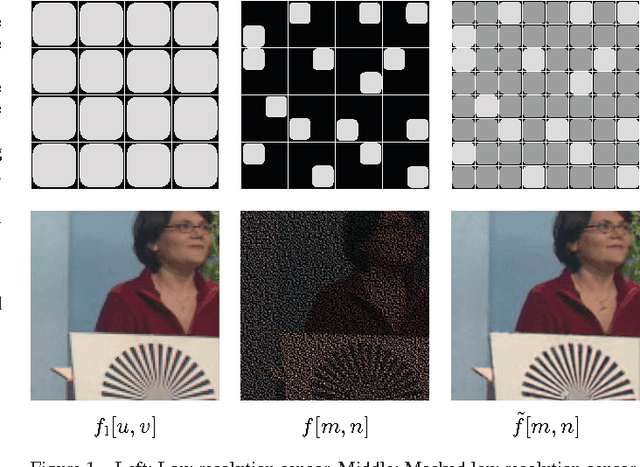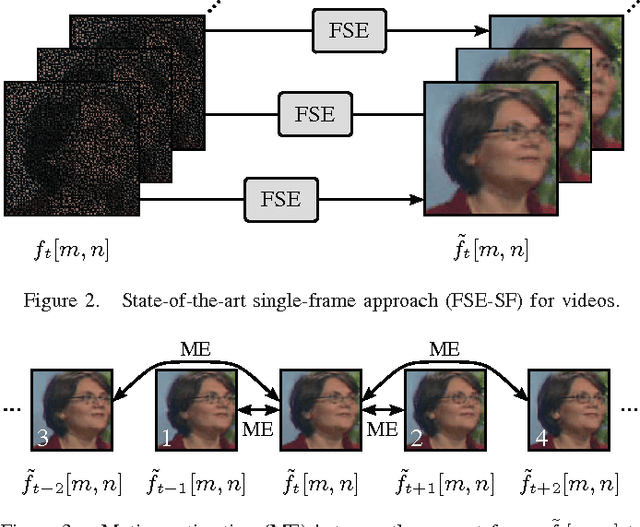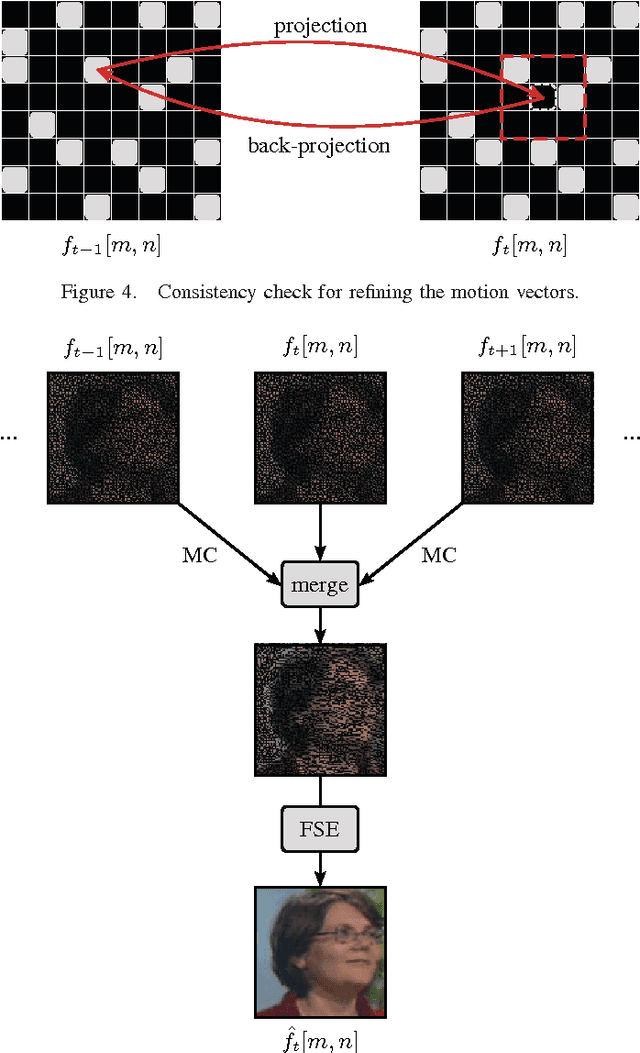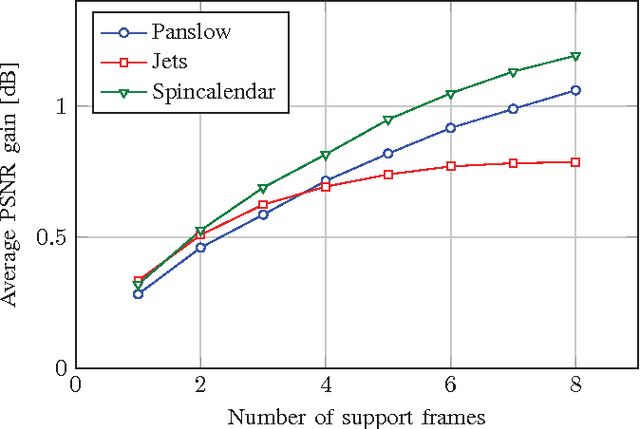Wolfgang Schnurrer
Temporal Scalability of Dynamic Volume Data Using Mesh Compensated Wavelet Lifting
Mar 01, 2023



Abstract:Due to their high resolution, dynamic medical 2D+t and 3D+t volumes from computed tomography (CT) and magnetic resonance tomography (MR) reach a size which makes them very unhandy for teleradiologic applications. A lossless scalable representation offers the advantage of a down-scaled version which can be used for orientation or previewing, while the remaining information for reconstructing the full resolution is transmitted on demand. The wavelet transform offers the desired scalability. A very high quality of the lowpass sub-band is crucial in order to use it as a down-scaled representation. We propose an approach based on compensated wavelet lifting for obtaining a scalable representation of dynamic CT and MR volumes with very high quality. The mesh compensation is feasible to model the displacement in dynamic volumes which is mainly given by expansion and contraction of tissue over time. To achieve this, we propose an optimized estimation of the mesh compensation parameters to optimally fit for dynamic volumes. Within the lifting structure, the inversion of the motion compensation is crucial in the update step. We propose to take this inversion directly into account during the estimation step and can improve the quality of the lowpass sub-band by 0.63 and 0.43 dB on average for our tested dynamic CT and MR volumes at the cost of an increase of the rate by 2.4% and 1.2% on average.
Analysis of mesh-based motion compensation in wavelet lifting of dynamical 3-D+t CT data
Feb 03, 2023Abstract:Factorized in the lifting structure, the wavelet transform can easily be extended by arbitrary compensation methods. Thereby, the transform can be adapted to displacements in the signal without losing the ability of perfect reconstruction. This leads to an improvement of scalability. In temporal direction of dynamic medical 3-D+t volumes from Computed Tomography, displacement is mainly given by expansion and compression of tissue. We show that these smooth movements can be well compensated with a mesh-based method. We compare the properties of triangle and quadrilateral meshes. We also show that with a mesh-based compensation approach coding results are comparable to the common slice wise coding with JPEG 2000 while a scalable representation in temporal direction can be achieved.
Centroid adapted frequency selective extrapolation for reconstruction of lost image areas
Jan 12, 2023Abstract:Lost image areas with different size and arbitrary shape can occur in many scenarios such as error-prone communication, depth-based image rendering or motion compensated wavelet lifting. The goal of image reconstruction is to restore these lost image areas as close to the original as possible. Frequency selective extrapolation is a block-based method for efficiently reconstructing lost areas in images. So far, the actual shape of the lost area is not considered directly. We propose a centroid adaption to enhance the existing frequency selective extrapolation algorithm that takes the shape of lost areas into account. To enlarge the test set for evaluation we further propose a method to generate arbitrarily shaped lost areas. On our large test set, we obtain an average reconstruction gain of 1.29 dB.
Analysis of displacement compensation methods for wavelet lifting of medical 3-D thorax CT volume data
Jan 11, 2023Abstract:A huge advantage of the wavelet transform in image and video compression is its scalability. Wavelet-based coding of medical computed tomography (CT) data becomes more and more popular. While much effort has been spent on encoding of the wavelet coefficients, the extension of the transform by a compensation method as in video coding has not gained much attention so far. We will analyze two compensation methods for medical CT data and compare the characteristics of the displacement compensated wavelet transform with video data. We will show that for thorax CT data the transform coding gain can be improved by a factor of 2 and the quality of the lowpass band can be improved by 8 dB in terms of PSNR compared to the original transform without compensation.
Efficient lossless coding of highpass bands from block-based motion compensated wavelet lifting using JPEG 2000
Jan 11, 2023Abstract:Lossless image coding is a crucial task especially in the medical area, e.g., for volumes from Computed Tomography or Magnetic Resonance Tomography. Besides lossless coding, compensated wavelet lifting offers a scalable representation of such huge volumes. While compensation methods increase the details in the lowpass band, they also vary the characteristics of the wavelet coefficients, so an adaption of the coefficient coder should be considered. We propose a simple invertible extension for JPEG 2000 that can reduce the filesize for lossless coding of the highpass band by 0.8% on average with peak rate saving of 1.1%.
On the influence of clipping in lossless predictive and wavelet coding of noisy images
Jan 11, 2023Abstract:Especially in lossless image coding the obtainable compression ratio strongly depends on the amount of noise included in the data as all noise has to be coded, too. Different approaches exist for lossless image coding. We analyze the compression performance of three kinds of approaches, namely direct entropy, predictive and wavelet-based coding. The results from our theoretical model are compared to simulated results from standard algorithms that base on the three approaches. As long as no clipping occurs with increasing noise more bits are needed for lossless compression. We will show that for very noisy signals it is more advantageous to directly use an entropy coder without advanced preprocessing steps.
Improving block-based compensated wavelet lifting by reconstructing unconnected pixels
Dec 08, 2022Abstract:This paper presents a new approach for improving the visual quality of the lowpass band of a compensated wavelet transform. A high quality of the lowpass band is very important as it can then be used as a downscaled version of the original signal. To adapt the transform to the signal, compensation methods can be implemented directly into the transform. We propose an improved inversion of the block-based motion compensation by processing unconnected pixels by a reconstruction method. We obtain a better subjective visual quality while furthermore saving up to 2.6% of bits for lossless coding.
3-D mesh compensated wavelet lifting for 3-D+t medical CT data
Dec 08, 2022



Abstract:For scalable coding, a high quality of the lowpass band of a wavelet transform is crucial when it is used as a downscaled version of the original signal. However, blur and motion can lead to disturbing artifacts. By incorporating feasible compensation methods directly into the wavelet transform, the quality of the lowpass band can be improved. The displacement in dynamic medical 3-D+t volumes from Computed Tomography is mainly given by expansion and compression of tissue over time and can be modeled well by mesh-based methods. We extend a 2-D mesh-based compensation method to three dimensions to obtain a volume compensation method that can additionally compensate deforming displacements in the third dimension. We show that a 3-D mesh can obtain a higher quality of the lowpass band by 0.28 dB with less than 40% of the model parameters of a comparable 2-D mesh. Results from lossless coding with JPEG 2000 3D and SPECK3D show that the compensated subbands using a 3-D mesh need about 6% less data compared to using a 2-D mesh.
Optimized processing order for 3D hole filling in video sequences using frequency selective extrapolation
Jul 20, 2022



Abstract:A problem often arising in video communication is the reconstruction of missing or distorted areas in a video sequence. Such holes of unavailable pixels may be caused for example by transmission errors of coded video data or undesired objects like logos. In order to close the holes given neighboring available content, a signal extrapolation has to be performed. The best quality can be achieved, if spatial as well as temporal information is used for the reconstruction. However, the question always is in which order to process the extrapolation to obtain the best result. In this paper, an optimized processing order is introduced for improving the extrapolation quality of Three-dimensional Frequency Selective Extrapolation. Using the proposed optimized order, holes in video sequences can be closed from the outer margin to the center, leading to a higher reconstruction quality, and visually noticeable gains of more than 0.5 dB PSNR are possible.
Reconstruction of Videos Taken by a Non-Regular Sampling Sensor
Apr 07, 2022



Abstract:Recently, it has been shown that a high resolution image can be obtained without the usage of a high resolution sensor. The main idea has been that a low resolution sensor is covered with a non-regular sampling mask followed by a reconstruction of the incomplete high resolution image captured this way. In this paper, a multi-frame reconstruction approach is proposed where a video is taken by a non-regular sampling sensor and fully reconstructed afterwards. By utilizing the temporal correlation between neighboring frames, the reconstruction quality can be further enhanced. Compared to a state-of-the-art single-frame reconstruction approach, this leads to a visually noticeable gain in PSNR of up to 1.19 dB on average.
 Add to Chrome
Add to Chrome Add to Firefox
Add to Firefox Add to Edge
Add to Edge